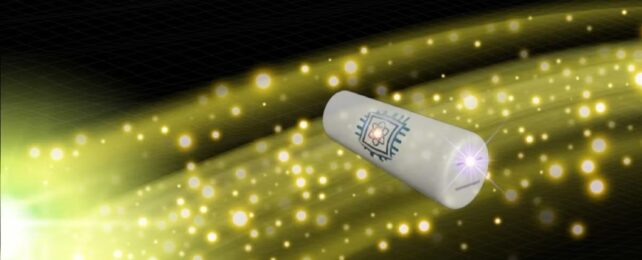The graviton – a hypothetical particle that carries the force of gravity – has eluded detection for over a century. But now physicists have designed an experimental setup that could in theory detect these tiny quantum objects.
In the same way individual particles called photons are force carriers for the electromagnetic field, gravitational fields could theoretically have its own force-carrying particles called gravitons.
The problem is, they interact so weakly that they've never been detected, and some physicists believe they never will.
But a new study, led by Stockholm University, is more optimistic. The team has described an experiment that could measure what they call the "gravito-phononic effect" and capture individual gravitons for the first time.
The experiment would involve cooling a massive, 1,800 kilogram (nearly 4,000 pound) bar of aluminum to a hair above absolute zero, hooking it up to continuous quantum sensors, and waiting patiently for gravitational waves to wash over it. When one does, the instrument would vibrate at very tiny scales, which the sensors could see as a series of discrete steps between energy levels.
Each of those steps (or quantum jumps) would mark the detection of a single graviton.
Any potential signal could then be cross-checked against data from the LIGO facility to ensure it's from a gravitational wave event and not background interference.
It's a surprisingly elegant experiment, but there is one catch: those sensitive quantum sensors don't actually exist yet. That said, the team believes that building them should be possible in the near future.
"We're certain this experiment would work," says theoretical physicist Thomas Beitel, an author of the study. "Now that we know that gravitons can be detected, it's added motivation to further develop the appropriate quantum-sensing technology. With some luck, one will be able to capture single gravitons soon."
Of the four fundamental forces of physics, gravity is the one we're most familiar with on a daily basis, but in many ways it remains the most mysterious. Electromagnetism has the photon, the weak interaction has W and Z bosons, and the strong interaction has the gluon, so according to some models gravity should have the graviton. Without it, it's a lot harder to make gravity work with the Standard Model of quantum theory.
This new experiment could help, ironically by returning to some of the earliest experiments in the field. Starting in the 1960s, physicist Joseph Weber tried to find gravitational waves using solid aluminum cylinders, which were suspended from steel wire to isolate them from background noise. If gravitational waves swept past, the idea goes, it would set off vibrations in the cylinders that would be converted into measurable electrical signals.
With this setup, Weber insisted he detected gravitational waves as early as 1969, but his results couldn't be replicated and his methods were later discredited. The phenomenon would remain undetected until LIGO found them in 2015.
Weber wasn't specifically looking for gravitons, but it might be possible with a 21st century upgrade to his experiment. Cryogenic cooling, along with protection from noise and other vibration sources, keeps the aluminum atoms as still as possible, so potential signals are clearer. And having a confirmed gravitational wave detector on-hand is helpful too.
"The LIGO observatories are very good at detecting gravitational waves, but they cannot catch single gravitons," says Beitel. "But we can use their data to cross-correlate with our proposed detector to isolate single gravitons."
The researchers say the most promising candidates are gravitational waves from collisions between pairs of neutron stars, within LIGO's detection range. With each event, an estimated one undecillion gravitons (that's a 1 followed by 36 zeroes) would pass through the aluminum, but only a handful would be absorbed.
The last puzzle piece is those pesky quantum sensors. Thankfully, the team believes that technology isn't too far out of reach.
"Quantum jumps have been observed in materials recently, but not yet at the masses we need," says Stockholm University physicist Germain Tobar, an author of the study. "But technology advances very rapidly, and we have more ideas on how to make it easier."
The research was published in the journal Nature Communications.
